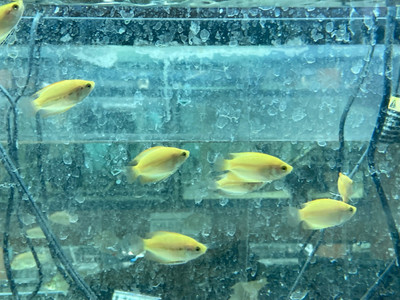Dwarf Gold Honey Gourami (Trichogaster chuna)
Posted by Max Gandara on on 13th Sep 2024
Dwarf Gold Honey Gourami (Trichogaster chuna) – A Complete Care Guide
Latin Name: Trichogaster chuna
Common Names: Dwarf Honey Gourami, Gold Honey Gourami, Sunset Honey Gourami
The Dwarf Gold Honey Gourami, known for its brilliant golden-yellow coloration and peaceful temperament, is a small labyrinth fish that is a favorite among aquarists. This species, which hails from South Asia, is perfect for smaller, planted tanks due to its compact size and calm demeanor. In this blog, we'll explore the natural habitat of the Dwarf Gold Honey Gourami and provide tips for keeping them happy and healthy in an aquarium environment.
Dwarf Gold Honey Gouramis in the Wild
The Dwarf Gold Honey Gourami is native to the slow-moving rivers, ponds, and swamps of India and Bangladesh. These waters are often dense with vegetation and have a low oxygen content, which has led to the development of their labyrinth organ, allowing them to breathe air directly from the surface. This adaptation helps them thrive in oxygen-poor environments, making them hardy and easy to care for in a wide range of conditions.
In the wild, these fish are primarily found in warm, slightly acidic waters with dense plant cover. Their natural diet consists of small invertebrates, algae, and organic matter. Their peaceful nature and small size allow them to live harmoniously with other species in their habitat.
Appearance and Behavior
The Dwarf Gold Honey Gourami is a small fish, typically growing to around 2 inches (5 cm) in length. Males are more vibrant than females, displaying striking golden-yellow or orange bodies with a slight reddish tint during breeding. Females, by contrast, are more subdued in color, often appearing pale yellow or silvery.
These fish are calm and peaceful, often spending their time exploring the middle and top levels of the tank. They are shy by nature but can become more confident in well-planted aquariums with plenty of hiding places. Male Honey Gouramis are known to build bubble nests and can become slightly territorial during breeding, but their aggression is minimal compared to other gourami species.
Aquarium Care for Dwarf Gold Honey Gouramis
The Dwarf Gold Honey Gourami is well-suited for community tanks and is highly recommended for beginner and intermediate aquarists alike. To ensure they thrive, it’s important to recreate their natural environment.
Tank Setup
- Tank Size: A minimum of 10 gallons is recommended for a pair of Dwarf Gold Honey Gouramis. For community setups, a 20-gallon tank or larger is ideal.
- Water Temperature: These tropical fish prefer temperatures between 74°F and 82°F (23°C to 28°C).
- Water Parameters: They thrive in slightly acidic to neutral water with a pH between 6.0 and 7.5 and a hardness range of 4 to 10 dGH.
- Filtration: A gentle filter is crucial, as they prefer slow-moving water. A sponge filter or a low-flow internal filter is ideal to avoid stressing them.
- Aquascaping: Dwarf Gold Honey Gouramis love heavily planted tanks, as it mimics their natural environment and provides them with shelter. Floating plants like duckweed or frogbit are also beneficial, offering surface cover that helps them feel secure.
Feeding
In their natural habitat, Dwarf Gold Honey Gouramis feed on small insects, invertebrates, and algae. In the aquarium, they are not picky eaters and will accept a variety of foods.
- Staple Diet: High-quality flake food or micro-pellets are suitable as a staple diet.
- Supplemental Food: Offering live or frozen foods such as brine shrimp, bloodworms, and daphnia can help enhance their coloration and keep them healthy. They also appreciate finely chopped vegetables like spinach or peas.
- Feeding Frequency: Feed them once or twice daily, ensuring only as much food as they can consume within 2-3 minutes.
Tank Mates
The Dwarf Gold Honey Gourami is a peaceful species that can cohabit well with other small, non-aggressive fish. Good tank mates include neon tetras, harlequin rasboras, ember tetras, and Corydoras catfish. Avoid pairing them with large or aggressive fish like cichlids, which could stress or outcompete them for food.
They do well in pairs or small groups. If keeping multiple males, ensure the tank has plenty of hiding places and plants to reduce any territorial behavior, especially during breeding.
Breeding Dwarf Gold Honey Gouramis
Breeding Dwarf Gold Honey Gouramis in captivity can be relatively easy with the right conditions. Like other labyrinth fish, the males are bubble nest builders, and they create nests at the water's surface using bubbles and plant material.
- Breeding Tank: A separate breeding tank with shallow water (around 6-8 inches) and plenty of floating plants is recommended. The water should be slightly warmer, around 80°F (27°C), to encourage breeding.
- Bubble Nest Building: Once the male has built his bubble nest, he will display to the female by flaring his fins and brightening in color. After mating, the female releases eggs, which the male carefully collects and places in the nest.
- Caring for Fry: The male will guard the nest until the eggs hatch, usually within 24-36 hours. Once the fry become free-swimming, it’s essential to remove the male to prevent him from eating them. Feed the fry infusoria or liquid fry food initially, and as they grow, move to baby brine shrimp or finely crushed flakes.
Conclusion
The Dwarf Gold Honey Gourami is a peaceful and visually striking addition to any aquarium. Their gentle temperament, combined with their hardy nature, makes them ideal for both novice and experienced fishkeepers. Whether you’re looking for a centerpiece fish for a nano tank or a peaceful addition to a community aquarium, the Dwarf Gold Honey Gourami is sure to bring a splash of golden color and calm activity to your aquatic world. With proper care, these beautiful fish can thrive and even breed in captivity, providing endless enjoyment for aquarists.

